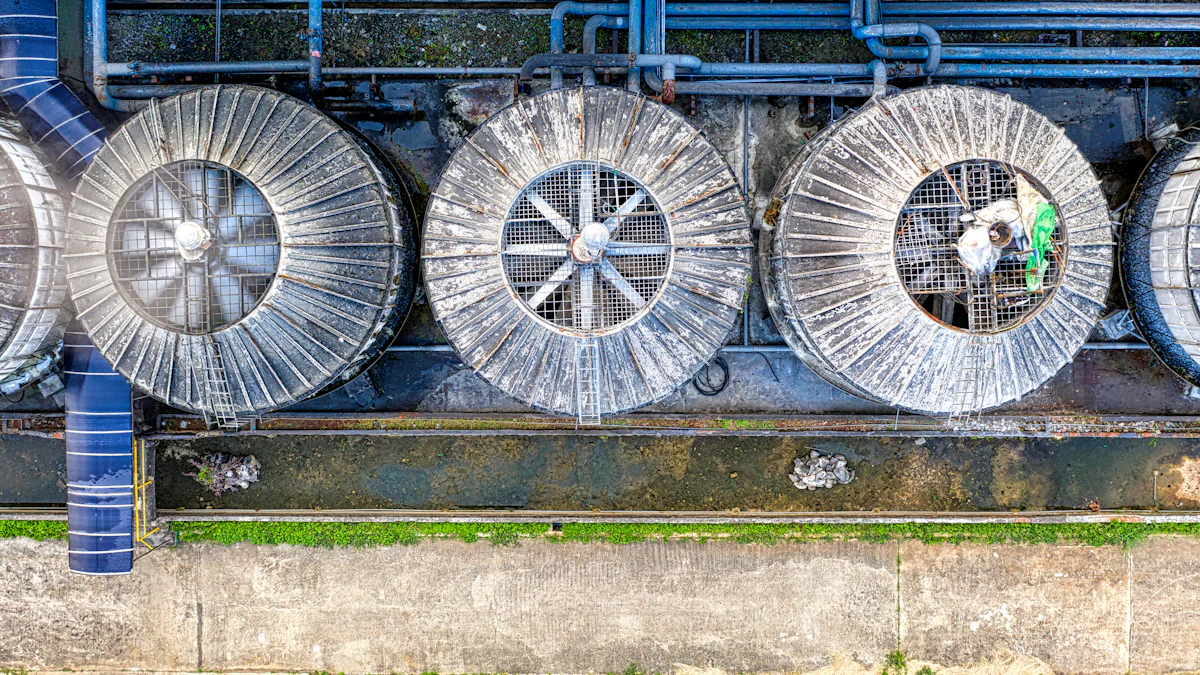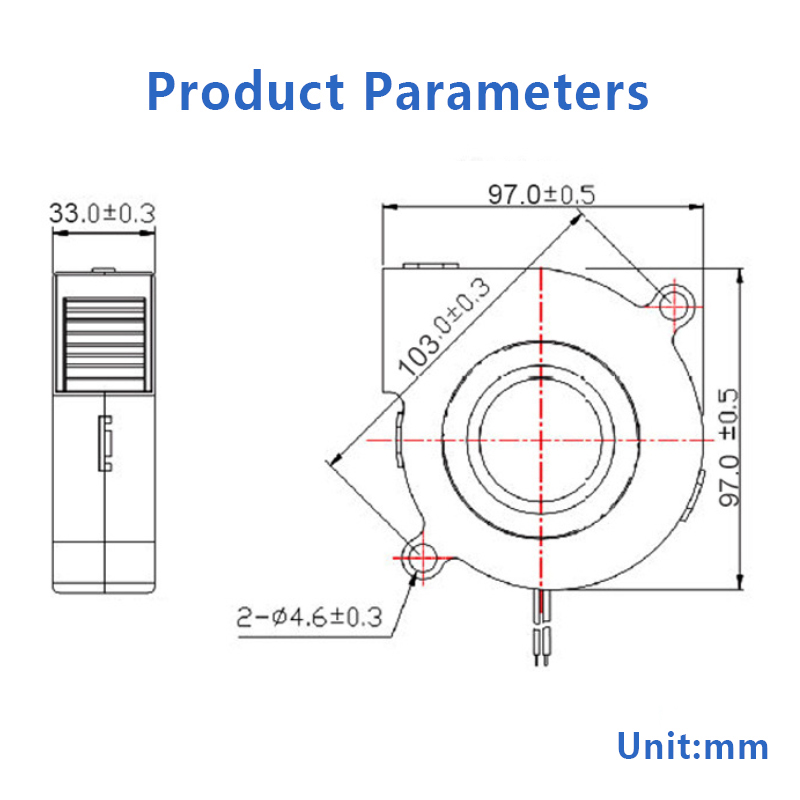What Are the Various Types of Blower Fans?

Ever wondered how a blower fan works? These fans play a crucial role in many industries. Factories and HVAC systems rely on them to move air efficiently. Blower fans help maintain airflow and temperature control. You might find them in manufacturing plants or even in your home. Each fan type offers unique benefits. Some provide high pressure, while others focus on energy efficiency. Understanding these differences can help you choose the right one for your needs.
What Are Blower Fans?
Blower fans move air or gas in various settings. These devices play a vital role in industries and homes. Understanding how blower fans work helps you appreciate their importance.
How Do Blower Fans Work?
Basic Principles
Blower fans operate by converting energy to move air. The fan blades spin, creating airflow. This process helps control temperature and ventilation.
Key Components
Blower fans consist of several parts. The motor powers the fan. The impeller moves the air. The casing directs airflow. Each component works together for efficiency.
Common Applications
Blower fans find use in many areas. Factories use them for ventilation. Homes rely on them for heating and cooling. Blower fans also support drying processes.
Why Are Blower Fans Important?
Industries depend on blower fans. Manufacturing plants use them to control air quality. Blower fans help maintain safe environments for workers.
Industries depend on blower fans. Manufacturing plants use them to control air quality. Blower fans help maintain safe environments for workers.
Environmental Impact
Blower fans contribute to environmental control. They help reduce pollution by filtering air. Efficient blower fans lower energy consumption.
Energy Efficiency
Energy-efficient blower fans save money. These fans use less power while maintaining performance. Choosing the right fan can reduce energy bills.
What Are the Main Categories?
Based on Design
Blower fans come in various designs. Centrifugal fans move air radially. Axial fans push air in a straight line. Each design suits different needs.
Based on Application
Applications determine fan choice. HVAC systems need specific blower fans. Industrial processes require robust designs. Selecting the right fan ensures optimal performance.
Based on Material
Materials affect blower fan durability. Aluminum fans offer lightweight options. Steel fans provide strength. Material choice impacts longevity and efficiency.
What Are Centrifugal Blower Fans?

Centrifugal blower fans play a vital role in moving air efficiently. These fans are popular in many industries due to their unique design and capabilities.
How Are They Designed?
Impeller Types
Centrifugal blower fans use different impeller types to move air. Backward-curved impellers offer high efficiency. Forward-curved impellers provide more airflow at lower speeds. Radial impellers handle heavy-duty applications.
Housing Design
The housing design of centrifugal blower fans impacts performance. Spiral-shaped housings direct airflow effectively. Compact designs save space. Each design suits specific needs and environments.
Airflow Patterns
Centrifugal blower fans create distinct airflow patterns. The air moves radially from the center. This pattern increases pressure and directs air where needed. Consistent airflow ensures optimal performance.
Where Are They Used?
HVAC Systems
Centrifugal blower fans excel in HVAC systems. These fans maintain air circulation in buildings. Efficient airflow helps control temperature and humidity. Reliable performance keeps indoor environments comfortable.
Manufacturing Processes
Manufacturing processes benefit from centrifugal blower fans. Factories use these fans for cooling machinery. Consistent airflow prevents overheating. Reliable fans ensure smooth operations.
Ventilation Systems
Ventilation systems rely on centrifugal blower fans. These fans remove stale air and bring in fresh air. Effective ventilation improves air quality. Healthy environments result from proper ventilation.
What Are Their Advantages?
Efficiency
Centrifugal blower fans offer impressive efficiency. These fans convert energy into airflow with minimal loss. High efficiency reduces energy costs. Choosing efficient fans saves money.
Durability
Durability defines centrifugal blower fans. Robust materials withstand harsh conditions. Long-lasting fans require less maintenance. Durable fans provide reliable service over time.
Versatility
Versatility makes centrifugal blower fans valuable. These fans adapt to various applications. Different designs meet specific needs. Versatile fans solve diverse challenges.
What Are Axial Blower Fans?

Axial blower fans have a unique design that sets them apart from other types of fans. You might wonder how these fans work and where they fit best. Let's dive into the details. axial blower fans
How Do They Differ from Centrifugal Fans?
Design Differences
Axial blower fans have a straightforward design. The blades rotate around an axis, pushing air in a linear direction. This design makes axial fans ideal for applications requiring high airflow with low pressure. Centrifugal fans, on the other hand, move air radially and are better suited for higher pressure needs.
Performance Characteristics
Axial blower fans excel in moving large volumes of air. These fans perform well in situations where space is limited. The simple design allows for efficient airflow with minimal energy use. Centrifugal fans offer higher pressure capabilities but may require more space and energy.
Cost Considerations
Axial blower fans often come at a lower cost compared to centrifugal fans. The simpler design reduces manufacturing expenses. Maintenance costs also tend to be lower due to fewer moving parts. For budget-conscious projects, axial fans provide an economical solution.
What Are Their Common Applications?
Cooling Systems
Axial blower fans play a vital role in cooling systems. These fans help dissipate heat in electronics and machinery. The high airflow capacity ensures effective temperature regulation. You can find axial fans in computers, refrigerators, and air conditioning units. axial blower fans
Exhaust Systems
Exhaust systems benefit greatly from axial blower fans. These fans efficiently remove stale air and fumes from enclosed spaces. The straightforward design allows for easy installation in ducts and vents. Axial fans help maintain air quality in kitchens, bathrooms, and industrial settings.
Agricultural Uses
Agricultural operations rely on axial blower fans for ventilation. These fans circulate air in greenhouses and barns. Proper airflow supports plant growth and animal health. Axial fans help control humidity and temperature in agricultural environments.
What Are Their Limitations?
Noise Levels
Axial blower fans can produce noticeable noise. The high-speed rotation of blades generates sound. Noise levels may become a concern in quiet environments. Selecting fans with noise-reducing features can help mitigate this issue.
Pressure Capabilities
Axial blower fans have limited pressure capabilities. These fans work best in applications requiring high airflow with low resistance. For tasks needing higher pressure, centrifugal fans may offer a better solution.
Maintenance Needs
Axial blower fans require regular maintenance. Dust and debris can accumulate on the blades. Routine cleaning ensures optimal performance. Keeping fans in good condition extends their lifespan and efficiency.
What Are Positive Displacement Blower Fans?
Positive displacement blower fans offer a unique way to move air or gases. These fans work differently from other types. You might wonder how these fans operate and where you can use them. Let's explore the details.
How Do They Operate?
Mechanism of Action
Positive displacement blower fans trap a specific volume of air. The fan then moves this trapped air through the system. This action creates a steady flow regardless of pressure changes. You get consistent performance with positive displacement blower fans.
Pressure Generation
The design of positive displacement blower fans allows for high-pressure generation. The fan's mechanism compresses the air as it moves. This compression results in increased pressure. High pressure makes these fans suitable for demanding applications.
Flow Control
Flow control stands out as a key feature of positive displacement blower fans. The fan maintains a constant flow rate. Changes in system pressure do not affect the flow. You achieve precise control over airflow with these fans.
Where Are They Typically Used?
Wastewater Treatment
Wastewater treatment facilities rely on positive displacement blower fans. These fans provide the necessary airflow for aeration tanks. Consistent air supply supports the breakdown of waste materials. You ensure efficient wastewater treatment with these fans.
Pneumatic Conveying
Pneumatic conveying systems benefit from positive displacement blower fans. These fans move materials through pipelines using air pressure. The consistent flow ensures smooth transportation of goods. You find these fans in industries handling bulk materials.
Chemical Processing
Chemical processing plants use positive displacement blower fans. The fans provide reliable airflow for various reactions. High pressure and consistent flow support complex chemical processes. You maintain safe and efficient operations with these fans.
What Are Their Key Benefits?
Consistent Flow
Consistent flow defines positive displacement blower fans. The fan delivers a steady stream of air or gas. System pressure changes do not disrupt the flow. You get reliable performance in critical applications.
High Pressure
High pressure sets positive displacement blower fans apart. The fan's design allows for significant pressure generation. This capability makes the fan ideal for challenging tasks. You meet demanding requirements with these powerful fans.
Reliability
Reliability remains a hallmark of positive displacement blower fans. The robust construction ensures long-lasting performance. Minimal maintenance keeps the fan running smoothly. You count on these fans for dependable service.
What Are Regenerative Blower Fans?
Regenerative blower fans offer a unique approach to moving air. These fans stand out with their specific design and efficiency. Let's dive into what makes regenerative blower fans special.
How Are They Constructed?
Impeller Design
The impeller design in regenerative blower fans plays a crucial role. The impeller has blades that capture air and move it along the fan's path. This design allows for continuous air movement. The impeller ensures efficient airflow without interruptions.
Casing Features
The casing features of regenerative blower fans enhance performance. The casing surrounds the impeller and guides the air. This structure minimizes air leakage and maximizes pressure. A well-designed casing boosts overall efficiency.
Airflow Dynamics
Airflow dynamics in regenerative blower fans differ from other fans. Air circulates within the fan multiple times before exiting. This circulation increases pressure and airflow. Regenerative blower fans achieve high pressure with low energy use.
What Applications Suit Them Best?
Aeration
Aeration systems benefit greatly from regenerative blower fans. These fans provide consistent airflow for water treatment processes. The steady air supply supports oxygenation in tanks. Regenerative blower fans ensure effective aeration.
Vacuum Systems
Vacuum systems utilize regenerative blower fans for their high pressure. These fans create strong suction for various applications. Industries rely on them for material handling and packaging. Regenerative blower fans deliver reliable vacuum performance.
Air Knife Systems
Air knife systems find regenerative blower fans ideal. These fans supply the necessary airflow for drying and cleaning. The high-pressure air removes moisture and debris efficiently. Regenerative blower fans enhance air knife system effectiveness.
What Are Their Unique Features?
Low Noise
Low noise levels make regenerative blower fans appealing. The design minimizes sound during operation. Quiet performance suits environments where noise reduction matters. Regenerative blower fans offer a peaceful solution.
Compact Size
Compact size defines regenerative blower fans. These fans fit into tight spaces without sacrificing power. The small footprint allows for versatile installation options. Regenerative blower fans adapt to various settings.
Energy Efficiency
Energy efficiency sets regenerative blower fans apart. These fans achieve high pressure with minimal energy consumption. The efficient design reduces operational costs. Regenerative blower fans provide an eco-friendly choice.
What Are Crossflow Blower Fans?
Crossflow blower fans have a unique design that makes them stand out. These fans offer specific benefits in various applications. Let's explore how crossflow blower fans function and where they excel.
How Do They Function?
Airflow Path
Crossflow blower fans create a wide airflow path. Air enters the fan and moves across the blades. This movement results in a consistent and even distribution of air. The design ensures effective air coverage.
Blade Arrangement
The blade arrangement in crossflow blower fans plays a crucial role. Blades are aligned in a cylindrical shape. This setup allows air to flow smoothly through the fan. The arrangement enhances performance and efficiency.
Efficiency Factors
Efficiency factors make crossflow blower fans appealing. The design minimizes energy loss during operation. Fans achieve high efficiency with low power consumption. Choosing these fans can lead to cost savings.
Where Are They Most Effective?
Air Curtains
Air curtains benefit from crossflow blower fans. Fans create a barrier of air that separates environments. This feature helps maintain temperature control. Crossflow fans improve energy efficiency in buildings.
Space Heaters
Space heaters use crossflow blower fans for effective heating. Fans distribute warm air evenly across spaces. This even distribution ensures consistent comfort. Crossflow fans enhance the performance of space heaters.
Cooling Towers
Cooling towers rely on crossflow blower fans. Fans move air efficiently to cool water systems. The design supports optimal cooling performance. Crossflow fans ensure reliable operation in cooling applications.
What Are Their Distinctive Characteristics?
Uniform Air Distribution
Uniform air distribution defines crossflow blower fans. Fans provide even airflow across entire areas. This characteristic ensures balanced temperature control. Crossflow fans deliver consistent results.
Quiet Operation
Quiet operation makes crossflow blower fans desirable. Fans produce minimal noise during use. This feature suits environments where noise matters. Crossflow fans offer a peaceful solution.
Design Flexibility
Design flexibility sets crossflow blower fans apart. Fans adapt to various applications and spaces. The compact design fits different installation needs. Crossflow fans provide versatile options for users.
How to Choose the Right Blower Fan?
Selecting the right blower fan can feel overwhelming. You want to make sure you pick the best one for your needs. Let's break it down into simple steps.
What Factors Should Be Considered?
Application Needs
First, think about where you'll use the blower fan. Different applications require different fans. A fan for a factory won't work well in a home. Make sure the fan matches the specific job.
Environmental Conditions
Next, consider the environment. Some fans handle heat better than others. Humid or dusty places need special fans. Choose a fan that fits the conditions.
Budget Constraints
Finally, look at your budget. Fans come in various price ranges. You don't want to overspend. Find a fan that offers good value without breaking the bank.
How to Evaluate Performance?
Airflow Requirements
Check the airflow requirements. Every application needs a certain amount of airflow. Make sure the fan provides enough air. Too little airflow won't do the job.
Pressure Needs
Look at the pressure needs too. Some tasks need high-pressure fans. Others work fine with low pressure. Match the fan's pressure capabilities to the task.
Energy Consumption
Consider energy consumption. Energy-efficient fans save money over time. Look for fans with low energy use. You'll cut down on electricity bills.
What Are the Maintenance Considerations?

Regular Inspections
Regular inspections keep fans running smoothly. Check the fan often for wear and tear. Catching problems early prevents bigger issues.
Component Replacements
Sometimes, parts need replacing. Motors and blades wear out over time. Keep spare parts handy. Quick replacements minimize downtime.
Cleaning Procedures
Cleaning is crucial too. Dust and debris slow down fans. Clean the fan regularly. A clean fan performs better and lasts longer.
You’ve explored various blower fans and their unique features. Choosing the right fan ensures efficiency and meets specific needs. Consider factors like application, environment, and budget to make a smart choice. Blower fans continue to evolve with technology. Future trends may bring more energy-efficient and quieter options. Stay informed to keep your systems running smoothly.
See Also
Comparison of Leading Brands in Blower Fan Industry
Advantages of Different Types of Cooling Fans
Choosing the Ideal Blower Fan for Your Needs
About US
X-HON
X- HON is a leading manufacturer of cooling fans,speciaizing in research, development, and production forover a decade. With a focus on quaity and inovation, we ofer arange of cooling solutions to global markets, ensuring superior performance and reliable service.
Address
Address1: HuaYuan Building, Xixiang Avenue, Bao'anDistrict, Shenzhen, Guangdong Province, china;
Address2: DaLingShan District, DongGuan,Guangdong Province, china
Contacts
frelin.jiang@x-hon.com
bella.cai@x-hon.com
+86 15626528321
To inquire about product specifications or to request custom fan designs,
please leave your email address.
Our dedicated service team will be in contact with you shortly.

